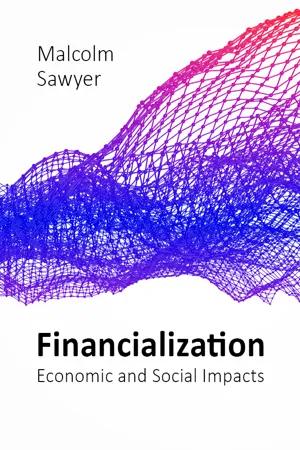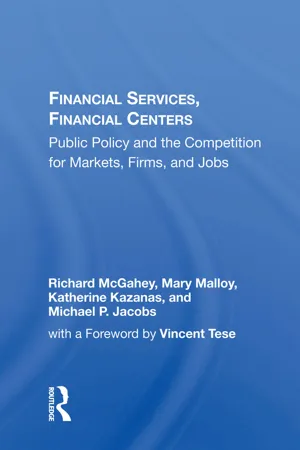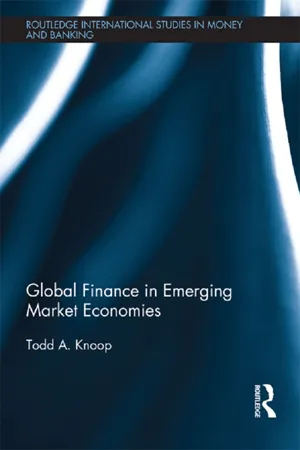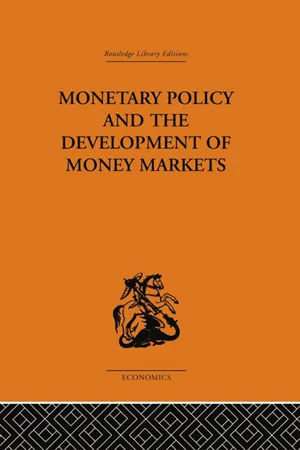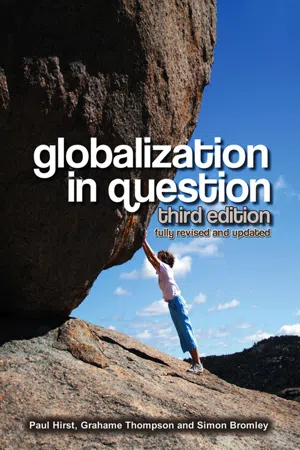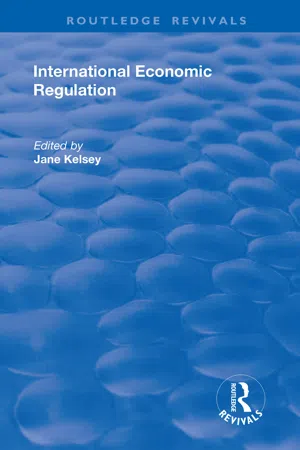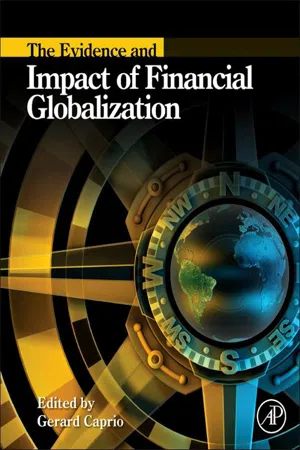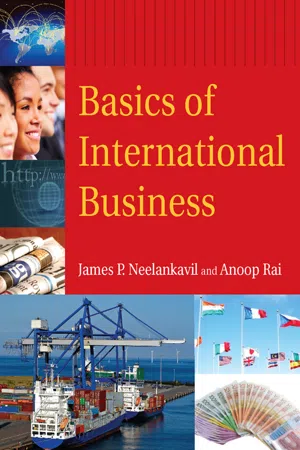Economics
Internationalization of Financial Markets
The internationalization of financial markets refers to the increasing interconnectedness and integration of financial markets across different countries. This process is driven by factors such as technological advancements, deregulation, and globalization, leading to greater cross-border capital flows, increased access to international investment opportunities, and the spread of financial risks and contagion.
Written by Perlego with AI-assistance
Related key terms
Related key terms
1 of 4
Related key terms
1 of 3
12 Key excerpts on "Internationalization of Financial Markets"
- eBook - ePub
Financialization
Economic and Social Impacts
- Malcolm Sawyer(Author)
- 2022(Publication Date)
- Agenda Publishing(Publisher)
Global financialization involves the growth of financial markets that operate on a global basis. The use of the term “market” brings connotations of a specific geographic location and with a very low degree of price diversity within the market. In the digital age, the location of buyers and sellers in a market becomes of less significance. Financial markets in different locations are linked – if a commodity is traded in several different markets, arbitrage between the markets would likely lead to some uniformity of price; the feasibility of such trading is dependent on the absence of controls on movement between countries and trading taking place in the same currency such as the US dollar. Global financialization also involves higher flows of capital between countries and particularly gross flows of capital – that is capital flows from country A to country B and from B to A, and again fostered by lowering or removal of capital controls. 2 The gross flows of capital across national borders have rapidly increased and current and capital account imbalances have grown. Global financial markets and linkages between national financial markets intensify. One measure of what is sometimes labelled “international financialization” is the ratio of foreign assets plus foreign liabilities to GDP of a country. The median value of that ratio for 24 industrialized countries since 1970 is shown in Figure 3.5 with a doubling of the ratio during the 1990s and a more than doubling between 2000 and the onset of the GFCs, and a flattening off after the GFCs. Figure 3.5 Foreign assets plus liabilities (percentage of GDP; median value for 24 countries) Source : calculated from Lane, P. & G. Milesi-Ferretti, External Wealth of Nations database (based on Lane, P. % G - eBook - ePub
Financial Services, Financial Centers
Public Policy And The Competition For Markets, Firms, And Jobs
- Richard McGahey(Author)
- 2019(Publication Date)
- Routledge(Publisher)
4 Globalization of FinanceIn recent years, references to the "globalization" of finance have become something of a cliche in the financial press. Yet globalization is a continuing transformation of major proportions and a significant part of the new competitive environment in financial services.The transformation of financing activities from segregated national debt and equity markets to a truly international capital market operating 24 hours a day is fostering continuing and growing international competition at home and abroad. U.S. financial firms are expanding to pursue opportunities abroad, establishing facilities and market presence in all parts of the world, particularly in London and Tokyo. In turn, foreign banks and securities firms, attracted by the size and stability of U.S. financial markets, are building a major cross-border presence to help satisfy their clients ' growing appetite for international borrowing and investing. The competitive pressure on financial services firms to establish and maintain such a presence has promoted the emergence of new financial centers and redefined the role of more established ones.This chapter outlines the dramatic changes that go by the name globalization. It goes on to discuss how these changes have occurred historically and what they mean for the competitive environment among firms. Finally, it examines how these changes are affecting the location of financial activity, with special attention to the three main global centers — London, Tokyo, and New York.Globalization is shorthand for the continuing international integration of the world's national financial markets. Financial markets around the world have become linked as never before into a single global pool of funds, accessible by customers and investors from all around the world, especially from the industrialized countries. Suppliers and demanders of capital no longer need to be in the same location in order to invest or borrow. Increasingly, investors are diversifying their portfolios across national boundaries. Corporations shop around the world for funds at the lowest cost. And investors engage in ever-more sophisticated transactions that present greater profit opportunities, or that meet special needs for diversification and risk management. - eBook - ePub
- Todd Knoop(Author)
- 2013(Publication Date)
- Routledge(Publisher)
Part III International finance in emerging markets 6 Financial liberalization and capital flows DOI: 10.4324/9780203068229-9 Introduction One of the most remarked upon trends in modern economics is globalization, or the increasing interconnectedness of economies across the globe. Globalization in the trade of goods and services, however, has been around since the late 1800s, although it was significantly interrupted by the Great Depression and two world wars. What is new today is financial globalization, or the free movement of financial assets across borders, and the extent to which it involves not just finance between developed countries but now also finance in emerging market economies. There has been a pronounced trend among emerging market economies toward freeing capital to move more easily between countries through the process of capital account liberalization. 1 Capital account liberalization involves the removal of constraints on the flow of foreign portfolio investment (the purchase by foreigners of financial assets such as stocks and bonds), foreign direct investment (investment by foreigners in structures, equipment, and organizations usually involving some operational control), and bank borrowing/lending across countries. Figure 6.1 presents data on net private capital inflows (inflows minus outflows) to the 30 largest emerging economies since the 1980s. Net private capital inflows to the largest emerging market economies were over $1 trillion in 2011 and 2012. This is below pre-global financial crisis levels in 2007 but up over 50 percent since 2009 - J.S.G. Wilson(Author)
- 2013(Publication Date)
- Routledge(Publisher)
14The Internationalization of Capital Markets255In recent years, the economies of many nations have tended to become increasingly inter-dependent. This has been reflected both in the amount of assistance given to the developing countries and in the growth of world trade. Because of the enlarged international flow of financial capital, the machinery of the capital markets has had to be refurbished and adapted to new uses. In this article, it is proposed first to outline the facts of the new trend towards the internationalization of capital markets; second, to explore the limits by which these developments are likely to be contained; and, finally, to discuss some of their possible repercussions and consequences.I
Although the present grows out of the past, it is many years since there was such an emphasis on internationalism. The heavy unemployment and falling incomes of the early 1930s resulted not merely in a shrinkage in world trade but in the widespread out-break of national autarky. The Second World War which supervened though necessarily it led (between allies) to international co-operation of a sort, tended on the whole to reinforce autarky. Neither series of events was calculated to encourage the confidence of investors and international investment (at least for constructive purposes) languished. Immediately after the war, in a world of shaky currencies and much social and industrial devastation, the first priority was reconstruction on a vast scale and without too obviously counting the cost. Latterly, on the basis of these reconstituted economies, the emphasis has shifted to development and growth. At this stage, too, prices and profitability again began to provide the main criteria for economic action and this favoured the emergence of a capital market geared to satisfy not merely domestic but international needs as well.- eBook - ePub
- Paul Hirst, Grahame Thompson, Simon Bromley(Authors)
- 2015(Publication Date)
- Polity(Publisher)
The importance of this assessment of openness and integration is obvious. It has to do with the ability of distinct national economies to devise and regulate their own economic policies. The fact that the degree of constraint on national economies in the Gold Standard period seems to have been consistently greater than at any time since should not blind us to the problems and issues facing economies because of the level of integration at the present time. It is certainly the case that, on the basis of some of the measures discussed above, the level of economic integration has increased since 1960 – though this is not obvious on just the savings–investment measure, except perhaps for the most recent period. In addition, it would be difficult to accept that the qualitative dimension has been constant over the entire period since 1870. The number and range of financial instruments has changed dramatically since 1960, for instance, and with them new problems of management and regulation have arisen (Turner 1991; Cosh et al. 1992). Before we examine the internationalization of money and short-term capital markets, however, we need to look to the more mundane areas of financial integration to see whether the underlying framework for the operation of capital markets has radically changed in the recent period. Money markets are probably more highly integrated than are capital markets. But it is capital markets that most immediately affect the economic prospects for the long-term growth of national economies.Developments in international financial market activity up to the late 1990s
This section investigates financial market developments up until the mid- to late 1990s. More recent changes and their implications are assessed in chapters 5 and 6 in particular. The key issues can be posed by first investigating the cross-border transactions and holdings of bonds and equities between countries and in various domestic financial institutions. As a percentage of GDP, the cross-border transactions in bonds and equities have escalated since the mid-1970s, as shown in table 2.11 . But if this is looked at from a slightly different angle, changes may not appear quite so dramatic.For instance, table 2.12 shows the actual holdings of foreign bonds and equities in the accounts of institutional investors (not just transactions between countries), expressed as a percentage of their total holdings. This reveals a general trend in the growth of importance of foreign securities since 1980 (except for Austria). For most countries the foreign securities holdings by their institutional investors were in the 10 to 30 per cent range, with only the Netherlands, Ireland and New Zealand having a stake over 30 per cent. What the figures for 1993 in table 2.12 demonstrate, however, is the enormous variation between countries in terms of the importance of foreign holdings. Some financial systems were clearly much more ‘open’ than others on this measure. For instance, of the G5 large countries, the UK and Japan were much more ‘open’ than the USA, Germany and France. And this issue of the variation in financial systems is confirmed by the data collected in table 2.13 - eBook - ePub
The Contemporary Global Economy
A History since 1980
- Alfred E. Eckes(Author)
- 2011(Publication Date)
- Wiley-Blackwell(Publisher)
Chapter 8 Internationalization of FinanceThe world of finance is a complex one that ordinary people contact when they routinely cash a check or use a credit card, buy a stock or bond, obtain a home mortgage, or exchange currencies for their foreign travel. Few consumers seek to master the intricacies. The mysteries of finance are usually left to bankers, traders, investors, and other professionals whose occupations require a higher level of understanding. Many of the most successful financial professionals work in a few of the world’s money centers – London, New York, Tokyo, Frankfurt, and Hong Kong among others. In this interconnected world, it is possible for sophisticated investors to play the global markets from almost any location where there are cell phones and computers with internet access.Introduction to International FinanceSo what is international finance, and why has it become so volatile and controversial in recent years? The Bank for International Settlements (BIS), which is a bank for central bankers, based in Basel, Switzerland, compares the financial system to the plumbing on a home. When it works, it is taken for granted, but when it doesn’t the results can be highly disruptive. Just as a plumbing system depends on a steady flow of water, an economic system relies on available financing and dependable intermediaries like banks, credit unions, stock brokers, insurance firms, and the like. These institutions serve the important function of funneling money from persons who wish to save a portion of earnings to those who need to borrow to finance business activities or make large purchases. And these institutions, and their instruments, help shift the risk of failure to those better able to assume it.1But when these intermediaries – banks, brokerages, and insurance companies – lose trust in one another, perhaps because they cannot assess risks and value assets properly, the financial system clogs up, like a home’s plumbing. Without trade financing, exporters and importers cannot conduct business. Without credit, businesses cannot borrow to purchase needed materials and meet payrolls. And, in instances where banks cannot meet the demands for cash of their depositors and become insolvent, irrational behavior (panic) may ensue, paralyzing the whole economic system. - eBook - ePub
- Jane Kelsey(Author)
- 2018(Publication Date)
- Routledge(Publisher)
Part IIRegulating International Finance and InvestmentPassage contains an image
[5]
Regulating Global Financial Markets
SOL PICCIOTTO* AND JASON HAINES**This paper discusses the role of regulation in the emergence of a global system of linked financial markets. It traces the origins of the Internationalization of Financial Markets to the emergence of new competitive pressures, rooted in changes in the social structures of savings and investment, breaking down both national systems of financial control and international arrangements for monetary and financial co-ordination. These changes have been accompanied and facilitated by a process of international re-regulation, through informal specialist networks. Although these have facilitated the international diffusion of regulatory standards and practices, and attempted to co-ordinate them, they are greatly hampered by espousing the perspectives of the various markets and firms which it is their task to supervise. Together with their minimalist view of the aims of public legitimation and oversight of financial markets, they have proved inadequate to prevent the destabilizing effects of the new global finance on the world economy.This paper greatly benefited from a grant from the Leverhulme Trust to fund research by the authors into Regulation of Globalized Futures Markets. Earlier papers exploring these issues were presented to the Second Consortium on Globalization, Law and Social Sciences, University of Glasgow, June 1996; and the Third Consortium on Globalization, Law and Social Sciences, Institute for Law and Society, New York University, United States of America, April 1997. A draft of this paper was delivered at the W. G. Hart Workshop on Transnational (Corporate) Finance and the Challenge to the Law, Institute for Advanced Legal Studies, University of London, July 1998. We are grateful to the organizers and participants at these workshops for the opportunity to debate the issues, and especially to David Campbell, Kevin Dowd, and Dede Boden for many helpful comments and fruitful discussions, and to the journal's referees for specific suggestions. We would also like to thank the many financial market participants and regulators who have spared some of their valuable time to participate in our continuing research. - eBook - ePub
globalization
n. the irrational fear that someone in China will take your job
- Bruce C. Greenwald, Judd Kahn(Authors)
- 2008(Publication Date)
- Wiley(Publisher)
won had maintained its value of between 890 and 900 to the dollar throughout the summer, but in September it fell to 913 won per dollar (more won to the dollar means lower value of the won) on the way to 953 won to dollar on October 28.At the start of November, the finance minister insisted that the won would never be allowed to fall below 1,000 to the dollar and that South Korea would not require an IMF bailout package, with all the pain that that entailed. Sixteen days later, the authorities capitulated and announced they could no longer support the won; the exchange rate was then 1,009 to the dollar. On November 21, they sought help from the IMF. By the middle of February 1998, the won was trading at 1,700 per dollar, a decline of almost 50 percent since the previous summer. South Korean firms and banks, unable to service their dollar- or yen-denominated debt (estimated to account for $120 billion out of a total debt of $360 billion), were failing in large numbers. Even banks with available resources stopped lending money, and the ensuing credit crunch made things worse. Unable to finance production and investment, firms began to shrink their operations and lay off workers. Between September 1997 and February 1998, the South Korean stock market index declined from over 800 to below 280, a drop of more than 65 percent.Kwan Ju, with much of his savings having evaporated, was laid off in March 1998. His experience was shared by millions of people in developing or recently developed economies, and it was widely attributed to globalization.Flow of Funds
Financial markets are the one area where globalization appears to have had an unambiguous impact. The critical symptoms that first appeared in the mid-to-late 1980s have now become almost numbingly familiar. A developing economy implements financial markets and other reforms with the hope of attracting foreign capital to stimulate growth. The policy succeeds. Growth generates demands for imported goods, both equipment for firms and consumer goods for households. In China and some other countries, exports more than pay for this demand for imports. But elsewhere, export earnings are not large enough to cover the costs, and these countries need to borrow from abroad to fill the gap.1At first, foreign lenders are eager to accommodate this demand for funds. However, because they are unwilling to take on the additional risk of having the loans repaid in the local currency, which may depreciate, the debts are denominated in an international currency such as dollars. At the same time, foreign investors may help out by purchasing securities issued by governments, banks, and businesses in the now growing local economy. Over time, as the developing country continues to import more than it exports, foreigners come to hold more of its debt and its securities. The basic imbalance is exacerbated by interest and dividend payments, which grow along with the size of the debt and the number of shares owned abroad. At some point, there is a day of reckoning, and it is not pretty. - eBook - ePub
- Agata Gemzik-Salwach, Krzysztof Opolski(Authors)
- 2017(Publication Date)
- Routledge(Publisher)
This is consistent with the idea that BRIC countries invest abroad for reasons other than generating high value added. Indeed, emerging countries should ideally have greater opportunities domestically to invest in high value added activities. Moreover, the existing literature suggest that BRIC based companies mostly invest abroad to access European markets and therefore open up new channels through which to sell their products (Clegg and Voss, 2012; Holtbrügge and Kreppel, 2012). Given these trends, it is not surprising that their focus is on the services sector, and the financial sector in particular, which may facilitate their access to the European markets more than manufacturing activities.These results can also be interpreted through the lenses of financialization. Controlling financial sector companies in advanced economies may be a strategic goal for the emerging world. The role of finance has become so pervasive at the global level that such a strategy appears rational, even if it foregoes potentially more productive investment opportunities.ConclusionAn aspect of financialization is the greater financial integration across countries. In this chapter we explored a particular subset of such integration: foreign exchange reserves and direct investment from the developing world to European countries. It was shown that such investments are unlikely to bring benefits to Europe. Allocation to Euro-denominated reserves do not appear be a stabilizing force in European bond markets, and FDI is for the most part allocated to low value added, and in particular financial sector, activities.This shows how financialization permeates all international financial relations. Emerging and developing countries act in a world where finance is prominent by following its rules. Reserves are managed as any private portfolio would be managed, divesting from assets when risks appear to be higher, and controlling advanced countries’ financial companies becomes a strategic goal. As such, international financialization is as likely to be potentially disruptive to the developing world as it is unlikely to be beneficial to the advanced world. - eBook - ePub
- Xiaohu (Shawn) Wang(Author)
- 2020(Publication Date)
- Routledge(Publisher)
However, one obstacle for the future development in the foreign exchange market is the inactiveness of the forward foreign exchange market. Due to the extensive intervention in the forward foreign exchange market in the 1986–88 period, the forward exchange rate was greatly distorted and the forward market was almost closed. Even now, the forward foreign exchange market in Taiwan is not an active market, which makes it almost impossible for the exporters and importers in Taiwan to hedge their exchange rate risk. Moreover, without hedging opportunities, the businessperson will have to face all uncertainties induced by the fluctuation of the exchange rate. This of course makes it more difficult for an economy to adjust to a flexible exchange rate system, and hence harder to have a successful liberalization in the foreign exchange market.Figure 6.4 Money supply(M1B )Liberalization and Globalization of the Securities Market
Globalization of the securities market was a trend in the international capital market in the 1980s. Several factors contributed to this trend. Basically, the prominence of international trade and the development of multinational companies in recent years led to huge foreign holdings by individuals. In addition, technology innovations play an important role in the globalization process. For example, electronic fund transfer, automatic trading systems, and the cross-listing of securities by exchanges of different countries all hasten the pace of globalization of the securities market.In view of the globalization trend in the world, and also in view of recent volatilities in the stock market in Taiwan, globalization of the securities market in Taiwan has also been adopted as one of the major goals of the government in these past few years. Since a free capital movement is a precondition for an internationalized securities market, the relaxation of restrictions on capital movement is an important step for globalization. Therefore, before introducing the globalization of the securities market, I shall first turn to a brief discussion regarding the recent relaxation on capital movements.Relaxation of Restrictions on Capital Flows
Direct capital movement by the general public was greatly restricted in Taiwan before July 1987. However, there were official channels for capital flows long before that time. Specifically, according to the foreign exchange regulations, commercial banks are allowed to borrow foreign exchange from abroad, and any importer/exporter is eligible to borrow foreign exchange through commercial banks and to sell it in the foreign exchange market for the N.T. dollar. - (Author)
- 2012(Publication Date)
- Academic Press(Publisher)
Their findings suggest that foreign and independent institutional investors (mutual fund managers and investment advisors) can play an important role in improving corporate governance in the firms they invest, while other foreign institutions (such as bank trusts, insurance companies) have limited monitoring role because of their close relationship with the management. As a result, the presence of independent institutional investors enhances the shareholder value, improves operation performance, and reduces capital expenditure. However, a recent study by Gozzi et al. (2008) shows that ‘internationalization’ through debt and equity markets does not seem to spark enduring improvements in corporate performance that differ from the dynamics that follow domestic issuances. Macroeconomic Policies The fact that the recent period of financial globalization before the crisis was marked by disinflationary trends in virtually all economies around the world has led some authors to contend that financial globalization improves monetary policy outcomes. Rogoff (2007) argues forcefully that globalization has fostered rising competition in goods and labor markets (which reduces price levels and also increases wage and price flexibility), thereby making the real effects of unanticipated monetary policy actions smaller and more transitory. Consequently, there is less incentive for central banks to pursue inflationary policies (and less incentive for politicians to pressurize them to do so). Financial openness appears to complicate monetary policy implementation in developing countries (Hawkins, 2005 ; Spiegel, 2009 ; Wagner, 2001). For instance, globalization increases uncertainty about the output gap (more exposure to productivity shocks emanating abroad), the inflation gap (through the effects of inflows on asset prices), and the monetary transmission mechanism (central banks have less control over the operations of domestic commercial banks)- eBook - ePub
- James P. Neelankavil, Anoop Rai(Authors)
- 2014(Publication Date)
- Routledge(Publisher)
13 International Financial ManagementLEARNING OBJECTIVES
• To understand the various financial transactions undertaken by a multinational manager• To recognize the various financial institutions that will be faced by an international financial manager• To be aware of the various methods of payment available to an international financial manager• To understand the role of stock markets and the Eurodollar currency markets in international finance• To recognize how regulatory agencies in the United States and overseas countries can affect international financial decision makingINTERNATIONAL EXPANSION
When a company expands its business beyond its national borders by exporting or importing goods or services, the company’s financial manager has to deal with additional variables such as exchange rates, tariffs, and regulatory, legal, and cultural issues. The financial manager’s responsibilities increase further when the company establishes subsidiaries abroad, as he or she must deal with additional issues such as borrowing and lending in local markets and interacting with foreign governments, agencies, and institutions.The goal of this chapter is to provide an overview of the major decisions as well as the elements of the financial environment that will be faced by international financial managers. These include the various institutions in the marketplace, including banks and insurance companies, stock and debt markets, and regulatory agencies. Understanding the roles and structures of these institutions, which are integral to overseas business transactions, will help international financial managers appreciate the decision-making challenges facing them.We first identify the business variables that are important to financial managers when they expand into international business activities. We then discuss the institutions that are associated with the variables and the choices available to the multinational manager.
Index pages curate the most relevant extracts from our library of academic textbooks. They’ve been created using an in-house natural language model (NLM), each adding context and meaning to key research topics.
Explore more topic indexes
Explore more topic indexes
1 of 6
Explore more topic indexes
1 of 4
